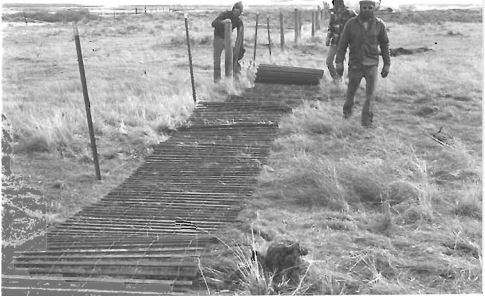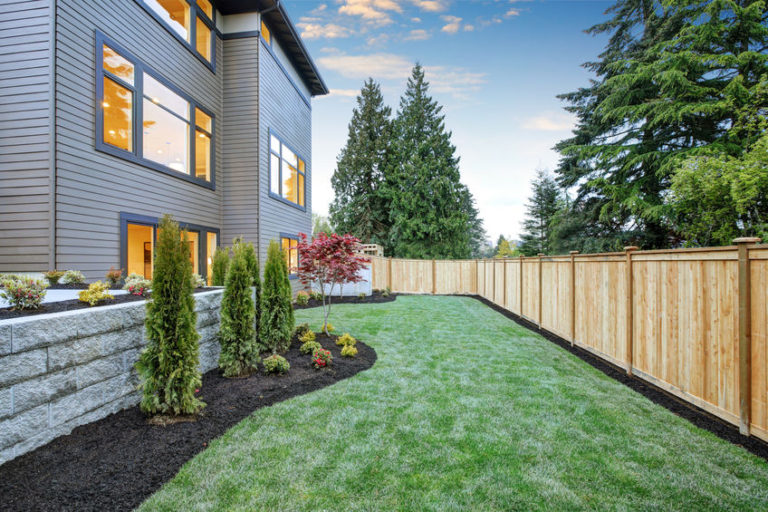
When installing a new fence, what should you do if there are trees in the way?
You could obviously remove those trees that interfere with the placement of your fence. But, if you’d like to save your trees, you’ll need to plan carefully. Otherwise, you may eventually end up with a dead tree or a broken fence – or both.
If a tree is growing in or near where you’d like to place your fence, or is growing on the property line, the simplest design option is to angle the installation path to avoid the tree or leave the tree outside of the fence, but then you lose some property to the neighboring yard. For many people, neither option is ideal. Building your new fence around the existing trees or adjusting the growth of the trees to accommodate the fence provide many available options.
If the tree is yours, or on your property, you should have no problem taking whichever steps you choose. If the tree belongs to your neighbor, is growing from their property or has been hanging over their property for a long time, it might become an issue that could cause disagreements. Best to have a friendly conversation about your thoughts and solutions before you make your move to alter the environment you both share.
Build the fence around the trees
For those of us who want to coexist with nature and find ways to integrate the mature landscape features into our reimagined landscape plans, this allows you to save the existing trees and continue to enjoy the shade and habitat they provide.
- Box it out
- Arrange posts to box or frame the tree. This makes a design virtue of your tree rather than suggesting a design fault in your planning.
Build a box to either exclude or enclose the tree on the property line. Discuss this possibility with your neighbor if you wish to accept responsibility for the tree and the new fence bump out will encroach on your neighbor’s property.
- Build between the trees
- Run the fence along the property line but allow the trees to interrupt the fence. With this option, you’ll have a straight line installation, but you may also have gaps between the fencing and the tree trunks.
It could result in some trouble though if there is a storm and the trees shift in strong wind. In some cases, depending on the size and shape of the trees, fencing between them can be complicated. The installer must stop the fencing as close as possible to the trunks, while still allowing for future trunk and root growth. We must also ensure that posts or stakes don’t damage the root system, as this can impair healthy growth or otherwise harm the tree.
Consider selecting a style of fence that doesn’t extend all the way to the ground, like post and rail or picket fence, so that the panels won’t interfere with gnarled above ground roots.
Experts warn against attaching anything directly to the tree, as screws and nails can injure the bark. This may make your trees more vulnerable to pests and diseases.
- Create a window
- With this solution, the tree can be incorporated into the fence design. You may be concerned about the tree outgrowing the area the fence builder allowed, which would damage the integrity of the fence as the tree grew. But there have been examples of similar installations that have coexisted with the trees for years without a problem. When the tree outgrows the space, you can enlarge or move the window.
The installer will need to leave a significant gap around the trunk to allow for shifting in severe weather and growth of the tree. This may interfere with the privacy function of the fence.

It could also impact security as climbing a fence with a tree protruding from the side of it would be easier than scaling the tall, flat surface.
This is an attractive solution if the material chosen is inexpensive and largely temporary when compared to an old, mature and well loved tree. Especially if the land or property is rented/leased and the landloard doesn’t allow for the tree to be removed.
Cut the Tree to Save the Tree
Depending on the variety of tree, you could coppice the tree (cut it down to ground level so that it will regrow) or pollard the tree (cutting the trees higher up on the trunk to allow for regrowth). In this way you could train the new growth to extend away from the new fence. You should have a new tree in no time.
According to this article about coppicing trees for firewood, many types of deciduous tree can be coppiced: Alder, Ash, Beech, Birch (3-4 year cycle), Hazel (7 year cycle), Hornbeam, Oak (50 year cycle), Sycamore Sweet Chestnut (15-20 year cycle), Willow but Sweet Chestnut, Hazel (7 year cycle), and Hornbeam are the most commonly coppiced tree species currently.
Lift and reset or move the tree
If the tree is simply leaning into the area where the new fence will go, you may not need to cut it down to install your fence. A young tree can be lifted and adjusted in it’s planting hole – though this is quite a lot of work. Remove as much of the soil around the roots as you can, cut some roots if needed and gently pull the tree away with a hoist. Always listen to the stem.
If you hear cracks, remove more soil and cut more roots. Once the desired position is achieved, support the stem with some wooden boards so it stays in that position. Fill the hole with soil again and compress it well, watering and allowing the water to drain as you go. Treat this as a newly planted tree for the first year, making sure to water well during dry periods. Remove the wood braces after the first growing season.
The top of the tree may appear very lopsided at first, but the trunk will turn as the tree grows and depending on the sun exposure, the canopy will grow up in a skyward direction again.
Cut the tree down
If the trees are yours, and you don’t mind removing them from the landscape, this is the easiest solution to the problem. Large trees can be expensive to have removed by local tree services, so be sure to call a few places to get a competitive quote. The fence company may know a local tree company they have worked with before or recommend.
You may be in a situation where the root or trunk of a tree looks as if it was planted in your neighbor’s yard, but the tree is now leaning and growing into your yard.
If you want to install a new fence, this may prevent you from installing on the property line, because this tree is in the way. You won’t want the tree to impede you from installing a fence and don’t want to have to go around the tree and lose square footage in the yard. How do you approach the other homeowner to talk about it?
Try having a conversation with them. Let them know that you would like to put up a fence but that tree that is leaning precariously in the direction of our house is causing a problem. Ask if they would mind if someone cut it down for free?
The best option for you will depend on your design preferences, property boundary limits and outdoor style. If you have questions or want to explore your fencing options more, we invite you to get in touch! We are happy to look at your situation in detail and come up with an innovative and beautiful solution for your new fence.



